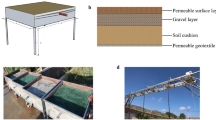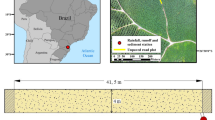Abstract
Despite the popularity of the permeable pavements in urban areas in recent years, a few empirical equations have been developed to estimate the time of concentration (Tc) on pervious surfaces, and almost none of them is evaluated over the permeable pavements. In this paper, we aim to investigate the effect of low impact development (LID) on Tc and develop a new equation for estimating overland flow Tc compatible with both permeable and impermeable pavements in small urban watersheds with a semi-arid climate. An experimental model was devised to determine the new equation. Synthetic rainfall (22–40 mm.h−1) was applied to a rectangular shaped (6 m × 1 m) test watershed with an adjustable longitudinal slope (0.5–8%) and zero lateral slope. Porous asphalt and permeable interlocking concrete paver (PICP) were employed as the permeable pavements. Then, to validate the obtained equation from experimental data, a field study was conducted over a 1-ha watershed during a Low intensity (<4 mm.h−1) rain event. The comparison between 13 empirical and semi-empirical equations (including the one developed in this study) for estimating Tc in the test condition indicates that Chen and Wong’s equation with −0.03 bias and the Nash-Sutcliffe efficiency (NSE) equal to 0.9 and 0.7 for impervious and pervious surfaces respectively is the most precise equation. On the other hand, for the field study, the newly developed formula outperformed other equations and estimated the Tc with a 3.7% error. Moreover, the results of experiments on the PICP surface showed that replacing 10 to 15% of an urban watershed surface by PICP in a region with the rainfall intensity less than 40 mm.h−1 and storm duration less than 1 h causes a considerable reduction (almost 100%) in the surface runoff.

Graphical abstract







Similar content being viewed by others
References
Akan AO (1986) Time of concentration of overland flow. J Irrig Drain Eng 112(4):283–292
Aksoy H, Unal NE, Cokgor S, Gedikli A, Yoon J, Koca K, Inci SB, Eris E (2012) A rainfall simulator for laboratory-scale assessment of rainfall-runoff-sediment transport processes over a two-dimensional flume. Catena 98:63–72
Ben-Zvi A (1970) On the relationship between rainfall and surface runoff on laboratory watersheds. Ph.D. thesis, CE Dept., Univ. Of Illinois, Urbana, IL
Ben-Zvi A (2013) Bypassing determination of time of concentration. J Hydrol Eng 18(12):1674–1683
Bondelid TR, McCuen RH, Jackson TJ (1982) Sensitivity of SCS models to curve number variation 1. JAWRA Journal of the American Water Resources Association 18(1):111–116
Chen C-N, Wong TSW (1993) Critical rainfall duration for maximum discharge from overland plane. J Hydraul Eng 119(9):1040–1045
Christiansen JE (1942) Irrigation by sprinkling. Univ Calif Agric Exp Stn Bull 670
Clark CO (1945) Storage and the unit hydrograph. Proc Am Soc Civ Eng 69(9):1333–1360
Eagleson PS (1970) Dynamic hydrology. McGraw-Hill, New York
Fang X, Cleveland TG, Garcia CA, Thompson DB, Malla R (2005) Estimating timing parameters of direct runoff and unit hydrographs for Texas watersheds. Lamar University. Technical report 0–4696-1
Fang X, Thompson DB, Cleveland TG, Pradhan P, Malla R (2008) Time of concentration estimated using watershed parameters determined by automated and manual methods. J Irrig Drain Eng 134(2):202–211
Federal Aviation Administration (1970) Advisory circular on airport drainage. Department of Transportation. Rep. A/C 150–5320-5B. Washington, D.C
Gericke OJ, Smithers JC (2014) Review of methods used to estimate catchment response time for the purpose of peak discharge estimation. Hydrol Sci J 59(11):1935–1971
Grimaldi S, Petroselli A, Tauro F, Porfiri M (2012) Time of concentration: a paradox in modern hydrology. Hydrol Sci J 57(2):217–228
Hood MJ, Clausen JC, Warner GS (2007) Comparison of Stormwater lag times for low impact and traditional residential development. J Am Water Resour Assoc 43(4):1036–1046
Henderson FM, Wooding RA (1964) Overland flow and groundwater flow from a steady rainfall of finite duration. Journal of Geophysical Research 69(8):1531–1540
Izzard CF (1946) Hydraulics of runoff from developed surfaces from developed surfaces. Proc Highway Res Board 129–146
Kerby WS (1959) Time of concentration for overland flow. Civ Eng 29(3):174
Kirpich ZP (1940) Time of concentration of small agricultural watersheds. Civ Eng 10(6):362
Kuichling E (1889) The relation between the rainfall and the discharge of sewers in populous districts. Transactions of American Society of Civil Engineers 20(1):1–56
Li M-H, Chibber P (2008) Overland flow time of concentration on very flat terrains. Transportation Research Record: Journal of the Transportation Research Board 2060(1):133–140. https://doi.org/10.3141/2060-15
Li X, Fang X, Li J, KC M, Gong Y, Chen G (2018) Estimating time of concentration for overland flow on pervious surfaces by particle tracking method. Water 10(4):379
Liang J, Melching CS (2012) Comparison of computed and experimentally assessed times of concentration for a V-shaped laboratory watershed. J Hydrol Eng 17(12):1389–1396. https://doi.org/10.1061/(ASCE)HE.1943-5584.0000609
Linsley RK (1970) Discussion of urban runoff by road research laboratory method by M. L. Terstriep and J. B. Stall. J Hydraul Div 97(HY4):1100–1102
McCuen RH (2009) Uncertainty analyses of watershed time parameters. J Hydrol Eng 14(5):490–498
McCuen RH, Spiess JM (1995) Assessment of kinematic wave time of concentration. Journal of Hydraulic Engineering 121(3):256–266
McCuen RH, Wong SL, Rawls WJ (1984) Estimating urban time of concentration. J Hydraul Eng 110(7):887–904
Morgali JR, Linsley RK (1965) Computer analysis of overland flow. J Hydraul Div 91(3):81–100
National Association of Australian State Road Authorities (1986) Guide of the design of road surface drainage. Milsons Point, NSW, Australia
Natural Resources Conservation Service (1986) Urban hydrology for small watersheds. In: Technical release 55. D.C, Washington
Natural Resources Conservation Service (2010) National engineering handbook, part 630 hydrology, chapter 15 time of concentration
Papadakis CN, Kazan MN (1987) Time of concentration in small rural watersheds. Proc Engineering Hydrology Sump., A.S.C.E 633–638
Ritter A, Muñoz-Carpena R (2013) Performance evaluation of hydrological models: statistical significance for reducing subjectivity in goodness-of-fit assessments. J Hydrol 480:33–45
Terstriep ML, Stall JB (1969) Urban runoff by road-research laboratory method. J Hydraul Div 96(HY6):1809–1834
United States Army Corps of Engineers (USACE) (1954) Data report, airfield drainage investigation. Rep. Prepared for Los Angeles District for the Office of the Chief of Engineers, Washington, D.C
Viessman W, Lewis GL (2002) Introduction to hydrology. Prentice-Hall, Upper Saddle River, NJ
Wait IW, Simonton DS (2015) Evaluation of the SCS lag time method for steep. Rural Watersheds In World Environmental and Water Resources Congress 2558–2567
Wong TSW (2001) Formulas for time of travel in channel with upstream inflow. J Hydrol Eng 6(5):416–422
Wong TS (2005) Assessment of time of concentration formulas for overland flow. Journal of Irrigation and Drainage Engineering 131:383–387. https://doi.org/10.1061/(asce)0733-9437(2005)131:4(383
Woolhiser DA, Liggett JA (1967) Unsteady, one-dimensional flow over a plane—the rising hydrograph. Water Resour Res 3(3):753–771
Yen BC, Chow VT (1983) Local design storms, Vol III. Rep. H 38 No. FHWA-RD-82/065, US Dept. of Transportation, Federal Highway Administration, Washington, D.C
Zhang S, Liu C, Yao Z, Guo L (2007) Experimental study on lag time for a small watershed. Hydrological Processes: An International Journal 21(8):1045–1054
Acknowledgments
The authors thank the support from Metosak Company for providing gravel and sand, Tehran municipality (district 2) for delivering concrete paver, and the project manager of the Chitgar Lake for providing geotextile.
Author information
Authors and Affiliations
Corresponding author
Additional information
Publisher’s Note
Springer Nature remains neutral with regard to jurisdictional claims in published maps and institutional affiliations.
Rights and permissions
About this article
Cite this article
Ghazi Zadeh Hashemi, M.S., Tajrishy, M. & Jalilvand, E. The Impact of Pavement Permeability on Time of Concentration in a Small Urban Watershed with a Semi-Arid Climate. Water Resour Manage 34, 2969–2988 (2020). https://doi.org/10.1007/s11269-020-02596-3
Received:
Accepted:
Published:
Issue Date:
DOI: https://doi.org/10.1007/s11269-020-02596-3




